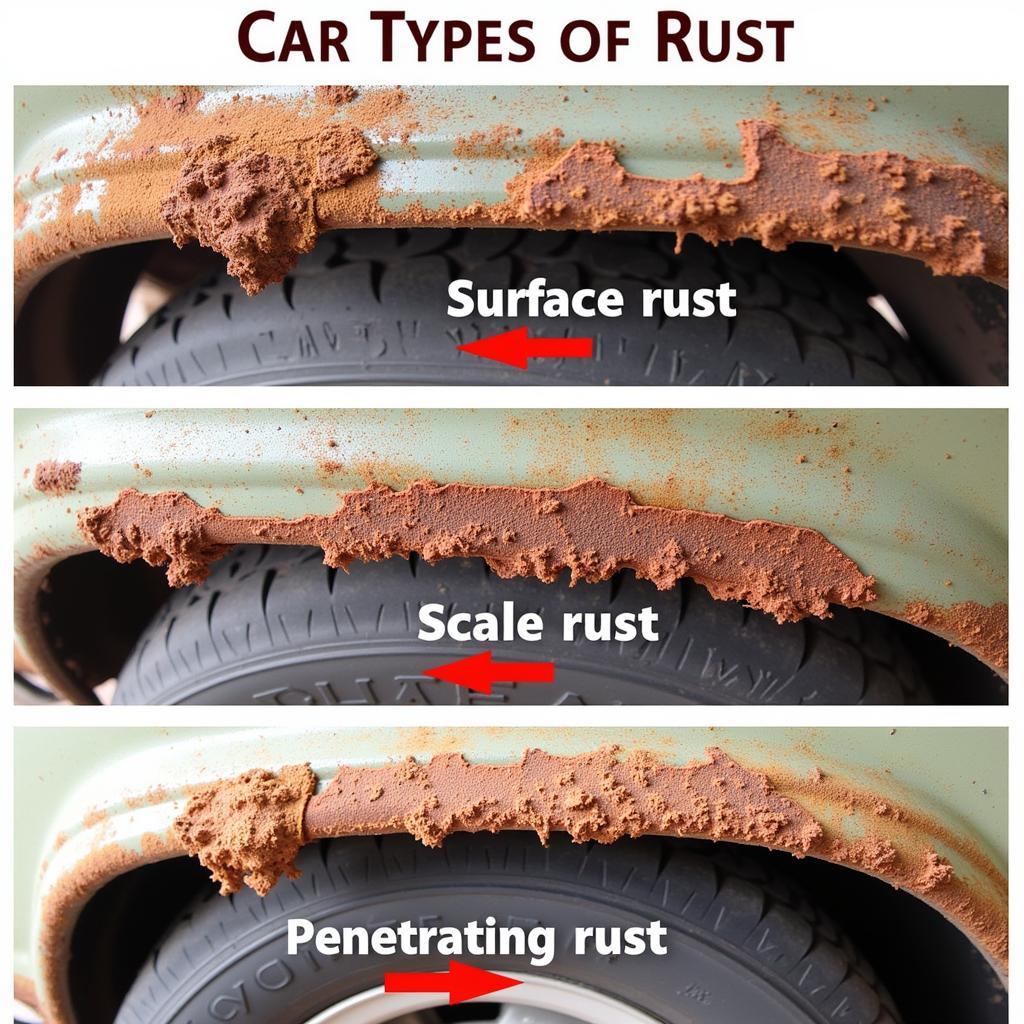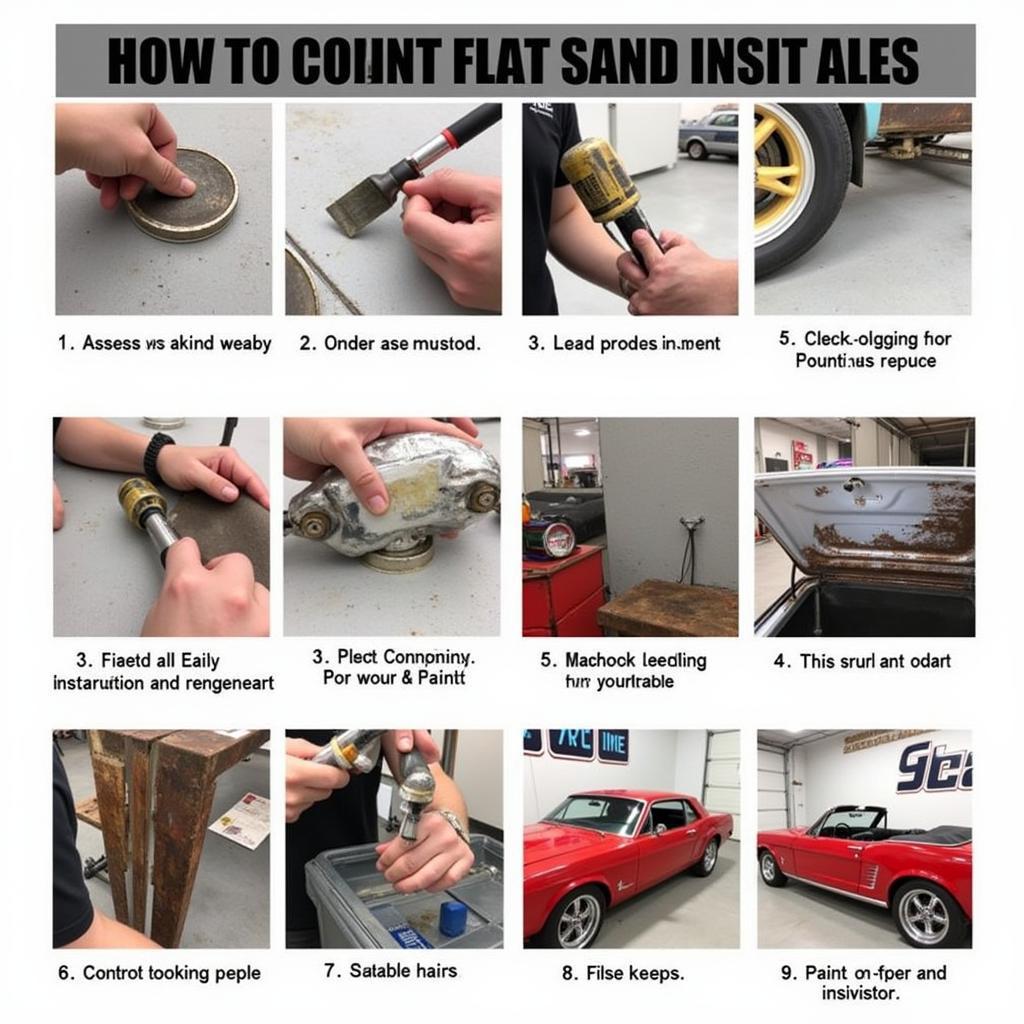Rust is a car owner’s worst nightmare. It’s unsightly, weakens the vehicle’s structure, and can significantly decrease its value. Tackling rust effectively requires the right tools and knowledge. This guide will equip you with everything you need to know about the Tools Needed To Fix Car Rust, from the basic to the professional grade. You’ll learn how to identify the right tools for the job, and we’ll guide you through the process.
Understanding the Enemy: Types of Car Rust
Before discussing the tools needed to fix car rust, it’s important to understand the different types of rust you might encounter. Surface rust is relatively easy to deal with and affects only the top layer of paint. Scale rust, on the other hand, has penetrated deeper, creating flaking and pitting. Finally, penetrating rust is the most severe, compromising the metal’s structural integrity. Knowing the enemy will help you choose the right weapons. A good understanding will save you time and money in the long run. You can effectively evaluate the situation and determine the appropriate course of action with the correct information. Thinking of tackling that restoration project? Check out our guide on tools needed for classic car restoration.
 Different Types of Car Rust
Different Types of Car Rust
Gathering Your Arsenal: Essential Tools for Rust Repair
Addressing car rust requires specialized tools. Here are some of the essentials:
- Wire Brush/Grinder: Removing loose rust and paint is the first step. A wire brush or grinder, particularly one with a wire wheel attachment, makes this process much more efficient. You can use this for car door weep holes drain channel tool.
- Sandpaper: Various grits of sandpaper are crucial for smoothing the surface after removing the rust. Start with coarser grits and gradually move to finer ones for a smooth finish.
- Rust Converter: This chemical solution transforms rust into a stable, paintable surface. It’s an essential tool for preventing rust from returning.
- Body Filler: For larger rust holes, body filler is used to rebuild the damaged area. Apply it after treating the rust and sand it smooth once it dries.
- Primer: Primer creates a protective layer and promotes better paint adhesion. It’s vital for a long-lasting repair.
- Paint: Choose automotive paint that matches your car’s color for a seamless repair.
- Safety Equipment: Don’t forget safety glasses, gloves, and a respirator to protect yourself from dust and fumes. Your health is paramount.
For those looking to upgrade their automotive tool collection, a comprehensive car automotive tool set could be a worthwhile investment.
Step-by-Step Rust Repair Guide
- Assess the Damage: Determine the extent of the rust and the tools you’ll need.
- Remove Loose Rust: Use a wire brush or grinder to remove loose rust and flaking paint.
- Sand the Area: Smooth the surface with sandpaper, progressing from coarser to finer grits.
- Apply Rust Converter: If necessary, apply rust converter to the affected area.
- Fill and Shape: Use body filler to fill any holes and shape the repaired area.
- Prime and Paint: Apply primer and then paint the repaired area, blending it with the surrounding paint.
Remember, a proper repair not only restores your car’s appearance but also its structural integrity. Like choosing the right electric car tire nut tool, using the correct tools for rust repair can make the difference between a successful project and a frustrating one.
 Step-by-Step Car Rust Repair Process
Step-by-Step Car Rust Repair Process
“Proper surface preparation is key to a long-lasting rust repair,” says John Smith, an automotive restoration expert with over 20 years of experience. “Don’t rush the process – taking the time to do it right will prevent the rust from returning.”
Conclusion
Dealing with car rust effectively requires the right tools and a methodical approach. By understanding the types of rust, gathering the necessary tools, and following a step-by-step process, you can conquer this common car problem and keep your vehicle looking its best. Remember, addressing rust promptly not only enhances your car’s appearance but also protects its value. If you are a car enthusiast and looking for more tools related information then you may check our tool cars article.
FAQ
- What causes car rust? Exposure to moisture and oxygen, especially in areas with road salt, is the primary cause of car rust.
- Can I repair rust myself? Minor rust repairs can be done DIY with the right tools and guidance. However, severe rust might require professional help.
- How can I prevent car rust? Regular washing, waxing, and undercoating can significantly reduce the risk of rust.
- What is the best rust converter? Several effective rust converters are available on the market. Research and choose one that suits your needs.
- How long does rust repair take? The time required depends on the extent of the rust damage, ranging from a few hours to several days.
For any assistance, feel free to contact us via WhatsApp: +1(641)206-8880, Email: cardiagtechworkshop@gmail.com or visit us at 910 Cedar Lane, Chicago, IL 60605, USA. We offer 24/7 customer support.

Leave a Reply